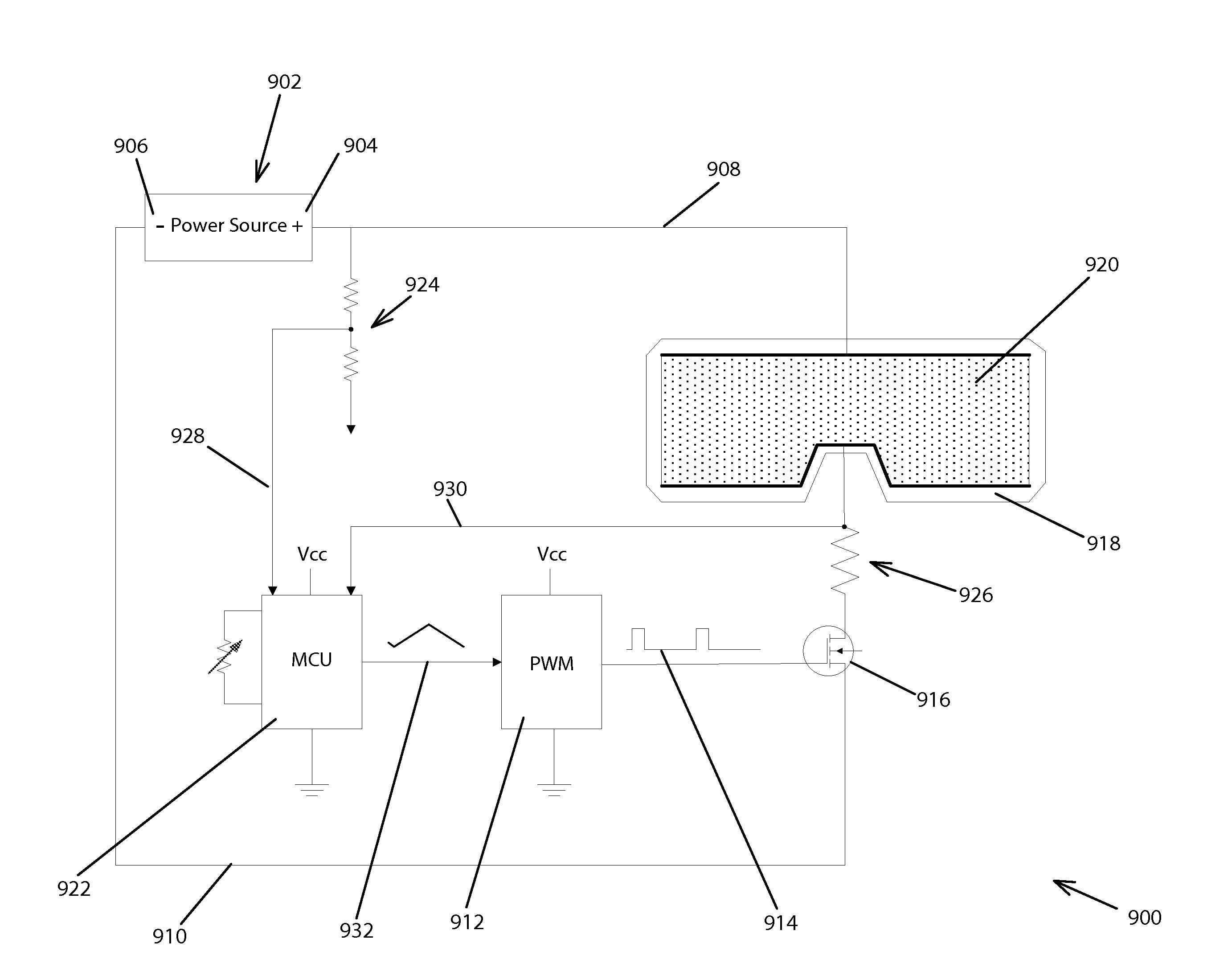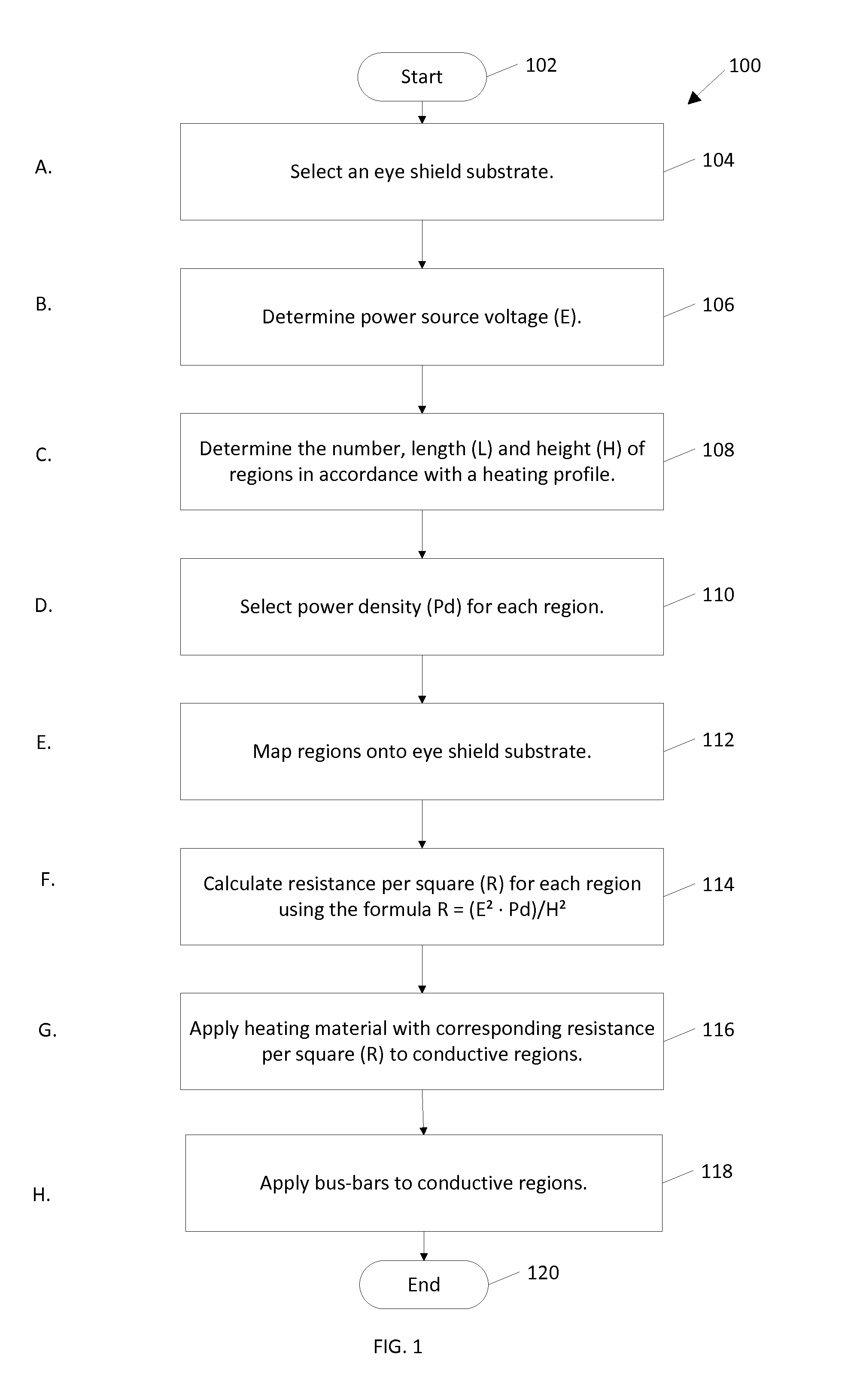When the temperature of such an eye-shield has dropped below a
dew-point temperature, i.e., the
atmospheric temperature below which water droplets begin to condense and
dew can form,
fogging has occurred and has obstructed vision.
Fogging that impairs vision is a common problem with such goggles, dive masks and eye-protecting shields.
However, without apportionment of the heater on the irregularly-shaped eye-shield lenses of these apparatus, such eye-shields have been subject to problems of creating hot spots on the irregularly-shaped lenses and have not provided for customizable heating of the lenses.
This newer
system has made use of apportioned heaters on an eye-shield, but there has developed the potential problem that the resistivity of the heater from one portion of the heater to another portion of the heater on the eye-shield may be different, and this would also lead to variations in heating across the eye-shield.
Further, an additional problem associated with a thin-film heater for eye-protecting shields has been the variations of resistance in the heaters encountered from one eye-shield to another eye-shield.
Accordingly, the undesirable effects on even, uniform, or otherwise expected, heating, resulting from varied resistance of a thin-film heater across an eye-shield, or from one eye-shield to the next, had not been appreciated until the Parent application and the PWM application had been implemented.
These variations of resistance have resulted primarily from difficulties experienced in applying the thin-film heating elements uniformly across the eye-shield surfaces, and from difficulties experienced in applying the thin-film heating elements consistently uniformly from one eye-shield to another.
Thus, the uneven and inconsistent application of thin film heating elements has created variations in resistivity across the eye-shield regions, and as a result, variations in heat supplied by the thin-film heaters on the respective eye-shield regions.
Either way, the problem is the same which has led to uneven, or otherwise undesirable, heating characteristics.
Accordingly, Curcio likewise does not teach even and consistent heating of multiple regions of a
single lens.
However, Reuber et al. does not disclose even heating of a lens, or alternatively customized heating of the lens in accordance with a heating profile, by employing a certain configuration of apportioned thin-filmed heating material on the lens.
Still further, Reuber does not teach even and consistent heating of one region of an eye-shield to the next region of the same eye-shield, or consistent heating among multiple eye-shields, through the use of an apportioned thin-film heater.
Thus, variations in the thickness of thin-film heaters applied to heat eye-shields to prevent
fogging have led to uneven heating over the entire surface of an irregular-shaped eye-shield, and in particular over multiple regions of a single irregular-shaped eye-shield or multiple irregular-shaped eye-shields.
Similarly, the prior art has not disclosed even and consistent heating of one region of an eye-shield relative to another region of the same eye-shield, or consistent heating from one eye-shield to the next, despite variable thicknesses of thin-film elements used.
The goggle of Lebel et al. would be susceptible to hot spots, and therefore using such a device in a limited battery-powered application would have unduly discharged the battery.
For example, where the terminals are on either side of the lens in a resistive wiring application, there have been problems with evenly heating the lens since the distance the wire has had to travel from one terminal to the other has been greater for those wires traveling over the bridge of the
nose and down under the eyes than other wires that travel the shorter distance across a central portion of the lens.
To overcome
fogging conditions enough power must be applied to overcome the
fog in the areas with the greatest distance between the terminal connection points, causing the shorter distance areas to overheat, which in turn has wasted power.
Thus, the problem has resulted in limited usefulness of heating of goggle eye-shields.
Because of the
irregular shape of eye-shields, these problems have existed whether one has considered resistive-wire applications or resistive-film applications.
Still another problem associated particularly with goggles and dive masks is the amount of space provided between the eye-shield portion of the device and the user's face.
Further, where excess distance has been provided between the shield portion of the device and the user's eyes, the ability to incorporate corrective lenses into the goggle or
mask eye-shield itself has been prohibited.
Increased distance between the user's eyes and the eye-shield has improved anti-fogging capability in typical air-flow dependent anti-
fog goggles, however, locating the eye-shield at such a great distance from the user's eyes to facilitate anti-fogging has made corrective goggle lenses ineffective for correcting vision, because excessive
lens thickness would have been required to accommodate the higher degree of curvature necessary in the lens to make the necessary vision correction.
 Login to View More
Login to View More  Login to View More
Login to View More 


